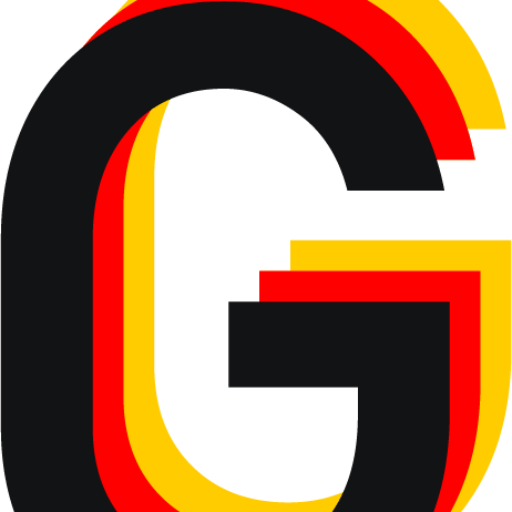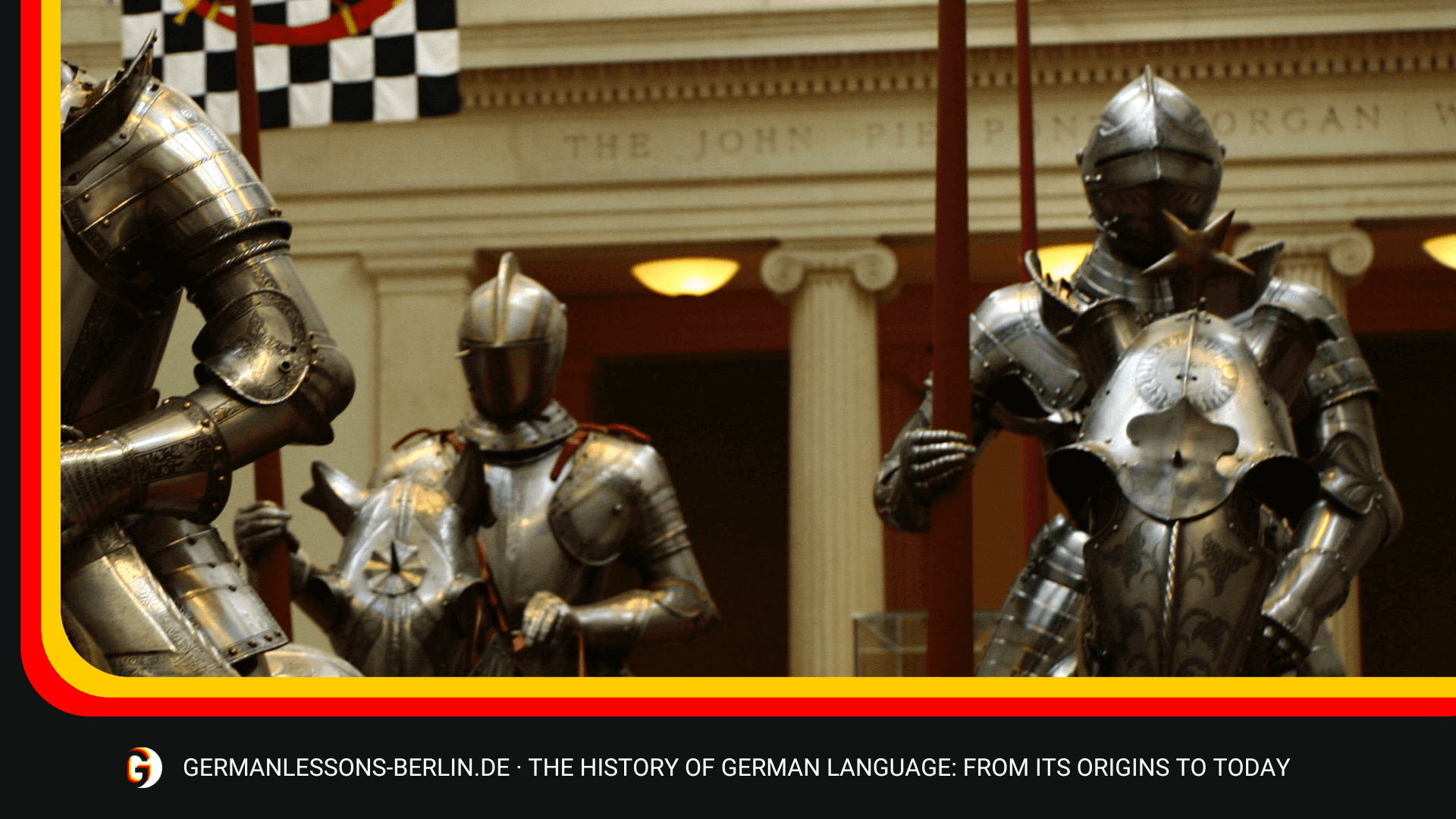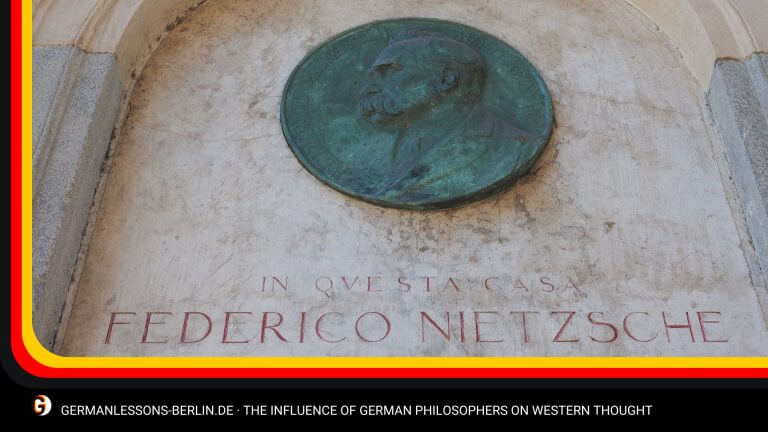The German language has a long and fascinating history that dates back centuries. It is the official language of Germany, Austria, Switzerland, Liechtenstein, Luxembourg, South Tyrol in Italy, and parts of Belgium. The origins of this language can be traced to the early Middle Ages when it was used as a common dialect among tribes living in what is known today as northern Germany and southern Denmark. As time went on and more countries adopted German as their primary language, its influence expanded throughout Europe. This article will provide an overview of the evolution of German from its earliest beginnings to the present day.
In its simplest form, the modern German language developed from several different West Germanic languages which originated during the Early Middle Ages. These include Old High German (OHG), Middle Low German (MLG), and Upper Saxon (US). OHG was predominant until about 1050 AD, when MLG began to take precedence due to increased urbanization in Central Europe. In 1450 AD US became increasingly influential with Martin Luther’s translation of the Bible into his own particular dialect of the US. Since then, various changes have taken place leading up to Modern Standard German, which is still spoken by millions around the world today.
This article aims to explore how these ancestral forms evolved over time into what we now recognize as Modern Standard German while also examining some current trends that are affecting the language today, such as regional variations or foreign influences like English words being integrated into everyday speech. By understanding how the past shaped our present-day version of this important European tongue, one can gain valuable insight into both its historical significance and cultural relevance for all those who speak it today.
Table of Contents
Definition Of Germanic Languages
Germanic languages are an important part of the history and culture of Europe. These languages have been around since before written records were kept, with many ancient roots in Proto-Indo-European language families. To understand how Germanic languages developed over time, it is important to first define what they are.
The term “Germanic” refers broadly to a group of related Indo-European languages spoken by various peoples across Northern and Central Europe. This includes modern-day Dutch, English, Afrikaans, Frisian, and Yiddish, as well as German itself. All these languages share similar characteristics, such as grammatical structure and some vocabulary items. The Proto-Germanic language is believed to be the ancestor of all the other Germanic languages, but its exact form remains unknown due to limited historical evidence from that period.
In addition to having common features between them, each Germanic language also has unique elements that make it distinct from others within the family. For example, Old High German was particularly influential on southern dialects, while Low German had a major impact on northern varieties like Danish or Swedish. Each language, therefore, has its own specific history and development, which can be traced back through centuries of study and research into linguistics. With this knowledge, we can better appreciate the rich diversity of today’s linguistic landscape in Europe. By delving deeper into the origins and evolution of these languages, we gain insight into their cultural significance throughout history up until today—and beyond!
The Proto-Germanic Language
The Proto-Germanic language is the common ancestor of all modern German languages, and as such, has had a significant impact on German culture. It has its roots in the ancient Indo-European family of languages spoken by many different peoples throughout Europe and Asia Minor. The earliest specimens of Proto-Germanic have been dated to around 500 BCE, although it was not until much later that this ancestral language began to take shape into the form we recognize today.
Proto-Germanic is characterized by a number of features:
- A distinct set of phonemes (sounds) is used in speech.
- An intricate system of grammatical rules governing word order and sentence structure.
- Close ties with other cultural traditions from which some words were borrowed or adapted over time.
As Proto-Germanic evolved, so did its associated culture and customs; however, these changes were gradual and not always easily discernible due to the lack of written records prior to the invention of writing systems across Europe in Roman times. Nonetheless, elements such as religious beliefs, social structures, folklore, and literature can still be traced back to their Proto-Germanic origins even today – providing us with an invaluable insight into our shared history as Germans. With Old High German up next in chronological sequence, let’s explore further how the evolution of the German language continued after the Proto-Germanic era came to an end.
Old High German
The roots of the German language can be traced back to Old High German (OHG), a West Germanic language, which is an ancestor of modern-day German. This ancient form of German was spoken from roughly 500 to 1050 CE in central and southern Germany. OHG belongs to the family tree of languages known as Proto-Germanic, also referred to as Common Germanic or Early Germanic. It has been described by some linguists as one of the most important developments in the history of European languages.
Old High German had its own script, known as ‘Runic’, which was used for writing during this period. Runic letters were derived from Latin and Greek alphabets and are believed to have first appeared around 400 CE. The script mainly contained consonants but included a few vowel characters that could modify sounds and indicate stress accents on certain words. These scripts formed the precursor to all other forms of written high germanic.
Although many words found in Modern Standard German still resemble their OHG counterparts, there have been significant changes since then; these include large vocabularies, major shifts in word order, pronunciation transformations, and inflectional endings becoming more complex over time. In short, while Old High German established many critical building blocks for later generations’ versions of the language – it differs greatly from contemporary forms.
Middle High German
Middle High German (MHG) is a term used to describe the language spoken between 1050 and 1350, which was the period of transition from Old High German to Early New High German. It developed as part of the High Medieval German dialects that emerged during this time, with influences from Latin, French, and Slavic languages. During the 11th century, MHG began to spread throughout parts of Germany and northern Europe. It eventually became the main literary language for most regions by the end of the 12th century.
The Middle High German literature produced during this era was mainly religious in nature, reflecting an interest in Christian ideals and traditional stories such as epics about courtly love or chivalric romance. The works of Wolfram von Eschenbach, Walther von der Vogelweide, and Gottfried von Strassburg were particularly influential at this time. While some authors wrote in Classical Latin, many others chose to write in MHG due to its popularity among readers.
In terms of vocabulary, MHG has had a lasting effect on modern-day German; around 80% of today’s words can be traced back to their roots in MHG. This includes numerals like einzige (unique), Wort (word), Schloss (castle) and Eisberg (iceberg). Even though it is no longer spoken today, elements of MHG are still seen in regional dialects across Germany and Austria. With its influence spanning more than 800 years, Middle High German continues to have an impact on contemporary culture worldwide.
Early New High German
Like a phoenix rising from the ashes, Early New High German (ENHG) emerged in the early 14th century as a distinct language. It was built on Middle High German and had an influence on Latin, French, Dutch, and English during its development. ENHG is notable for its shift in pronunciation – particularly of vowels – diachronic changes to noun endings, simplification of the verb system, introduction of new word formation processes such as compounding and derivation with prefixes/suffixes, and expansion of vocabulary due to borrowing foreign words.
One major feature of ENHG was that it became increasingly standardized across Europe despite regional differences in dialects. This can be attributed to increased communication facilitated by the invention of Gutenberg’s printing press around 1440, which made books more accessible than ever before. Furthermore, many social networks, such as universities, were founded throughout this time period which also helped spread ENHG beyond local boundaries.
The legacy of Early New High German continues today; although there are several modern german dialects, most native speakers still understand ENHG when spoken or written. Its impact on our current language cannot be denied – just look at any newspaper article or book! As we move forward into the future, it will remain an integral part of our linguistic heritage.
Modern German Dialects
The German language has developed several distinct modern dialects. Austrian German is spoken in Austria and contains some minor differences from Standard German, such as the use of diminutives instead of standard plurals. Swiss German differs not only in its pronunciation but also in lexical items and grammar structures; it is largely unintelligible to non-native speakers. Bavarian German is mostly similar to Austrian German. However, it contains a few unique words and expressions which are different from those used in other regions of Germany. Frisian, an old language that is closely related to English, is still spoken by a handful of people in northern Germany along the coast. Lastly, Saarlandic is considered a separate dialect due to its incorporation of French loanwords as well as certain grammatical features derived from neighboring Romance languages.
These diverse dialects have had an impact on all aspects of contemporary german culture, including literature and even film productions. In addition, there has been increasing interest among linguists in understanding how modern dialects differ from standard German and what role they play in the overall context of the country’s linguistic landscape. Understanding these distinctions can help us better understand the development of german over time and its influence on other cultures worldwide.
The complexity of this topic provides insight into how various cultures interact with one another through language – an interaction that inevitably shapes our perceptions of each other’s values and beliefs. This section will provide a further exploration into this phenomenon by examining the impact that other languages have had on German throughout history.
Impact Of Other Languages On German
The influence of other languages on German is evident in its history. Over the centuries, many foreign words and constructions have been absorbed into German, resulting in a language with strong linguistic ties to neighboring countries. The most significant impact has come from German-English contacts due to the close proximity between Germany and England. This can be seen in the large number of English loanwords that are now commonly used in everyday speech as well as formal writing. In addition, grammatical structures derived from English, such as word order and verb tense usage, have been adopted by modern speakers of German.
German has also been influenced by French, which was widely spoken among the upper classes during the Medieval period. Many words relating to politics and culture were borrowed directly from the French during this time, including terms related to government administration, art, and literature. Similarly, Dutch had an effect on early forms of written German, particularly when it came to vocabulary associated with trade and commerce. More recently, Slavic languages like Polish have left their mark on contemporary spoken German, while Latin borrowings remain present throughout much of the language’s lexicon today.
These various influences make up just one element of what makes up the rich cultural heritage behind the development of the modern-day German language. As we move forward into our exploration of literature and writing in the german language, we will gain further insight into how these factors shaped -and continue to shape- this fascinating linguistic landscape.
Literature And Writing In The German Language
The written German language is a tapestry of artistry, intertwining the works of poets, authors, and scribes throughout its long history. From its earliest days as an oral tradition to its current status as one of Europe’s most influential languages, German literature has been inextricably linked with the development of German culture.
Beginning in the Middle Ages, esteemed German writers such as Walther von der Vogelweide emerged on the scene to create epic poems that are still celebrated today. By the early modern period, german books were being published en masse by publishers across Germany, many of which featured key figures like Martin Luther or Johann Gutenberg. The Enlightenment saw even more prolific german authors who wrote about philosophy and science; Goethe stands out among them for his iconic work ‘Faust’. In later generations, renowned german poets such as Heinrich Heine and Rainer Maria Rilke pushed boundaries while exploring themes of love and loss through their writing.
Today’s literary landscape continues to be shaped by these great minds from centuries past. Contemporary German writers often draw influence from classic texts to craft stories that captivate readers both at home and abroad. As evidenced by this rich body of work spanning hundreds of years and thousands of pages, there is no doubt that German literature will remain an important part of our cultural heritage going forward. With these powerful words providing lasting insight into our collective experience here on earth, it becomes clear why the German language holds immense sway over so much of what we see around us today.
Influence Of The German Language Today
The German language today is one of the most influential languages in Europe. It has a long and established history, having been spoken for centuries. In recent times, it continues to be an important part of both European and global culture, with its influence being felt on many levels.
Modern German language usage encompasses many different forms, from conversational speech to formal written documents. It is used among native speakers as well as those who are learning or have learned the language through education or travel. The cultural influences of German can also be found in music, art, literature, and other aspects of life throughout much of Europe. For example, many words commonly heard in English – such as ‘kindergarten’ – are derived from German origins.
In addition to these examples, there are numerous professional fields that rely heavily upon knowledge of the German language; including business relations between Germany and other countries worldwide, international law enforcement agencies, engineering firms, and universities, all requiring familiarity with at least some degree of Modern German proficiency. Moreover, due to its widespread use by millions of people around the world every day, the language often serves as a bridge between cultures that may otherwise remain disconnected due to their diverse backgrounds. As such, it can serve an important role in fostering greater peace and understanding across boundaries.
German language culture is richly varied throughout Germany’s regions and beyond; each area has its own unique dialects and customs that represent distinctive expressions within the larger context of the nation’s collective identity. This diversity makes it essential for anyone attempting to learn a variety of modern German skillsets to become familiar with multiple regional varieties so they can more easily communicate effectively with individuals whose primary source language may vary greatly from their own. With this knowledge comes a deeper appreciation for both traditional heritage as well as contemporary trends within society–creating opportunities for further growth and exploration into what makes up Modern Germany’s unique character today.
Preservation Of The German Language
The preservation of the German language has been an important part of its history. From ancient times to today, the conservation and protection of this unique language have been a priority for those who speak it. The maintenance and safeguarding of its distinctive characteristics remain paramount in order to ensure that future generations can enjoy its richness and diversity.
| German Language Preservation | Benefits |
| Maintaining Characteristics | Encourages Cultural Identity |
| Protecting Grammar Rules | Enhances Intercultural Understanding |
| Conserving Vocabulary | Strengthens Regional Descriptors |
| Safeguarding Syntax | Bridges Historical Connections |
Germany’s commitment to preserving its native tongue is reflected in various public initiatives, such as promoting education about the importance of upholding cultural heritage through workshops and classes. Additionally, there are robust efforts from linguists, educators, and other members of the society dedicated to protecting current usage while expanding modern-day vocabulary with new words or phrases that reflect changing trends in culture. These initiatives demonstrate how fundamental german-language-preservation is to both past and present generations alike.
The need for continued growth within the German language remains crucial; not just for native speakers but also for international students seeking fluency. This requires dedication on behalf of all involved—native speakers must continue speaking it, learners must actively practice it, linguists must expand it, and technology should be utilized when available so that more people around the world may benefit from learning one of the most widely spoken languages in Europe. Through these collective efforts, we can honor our roots by keeping alive a linguistic tradition thousands of years old.
Frequently Asked Questions
What Is The Origin Of The German Language?
The German language is one of the most important languages in Europe and has a long and rich history. Its origin can be traced back to the Proto-Germanic language, which was spoken by the ancient Germanic tribes around 4500 BCE. Over time, this language evolved and developed into Old High German, Middle High German, Early New High German, and finally, Modern Standard German. The development of the language reflects its unique cultural and historical context throughout different periods of time.
During the medieval period (800s – 1500s), many linguistic changes occurred that shaped the current form of modern standard German as we know it today. This included shifts from Latin influence to French influence due to increased contact with other cultures during this era. In addition, certain dialects emerged, such as Saxon or Bavarian, due to geographical boundaries between regions. Furthermore, the invention of the printing press allowed for more widespread use of written forms which helped stabilize spelling conventions across Germany.
Today, there are over 100 million native speakers worldwide who speak various dialects of the language depending on their region or country. Additionally, there are numerous variations within each dialect that reflect local customs and traditions. Despite these differences in pronunciation or vocabulary among different areas, they all share a common basis dating back to Proto-Germanic roots, which demonstrates how influential german language evolution has been throughout history up until now.
How Has The German Language Changed Over Time?
German is a West Germanic language and has been spoken for centuries. Over time, the language has experienced various changes in its form and structure, reflecting the evolution of culture, technology, and society, as well as influences from other languages such as Latin or French. This article will explore how the German language has changed over time, with a particular focus on its development since its origins.
The earliest records of written German date back to 8th-century manuscripts that feature religious texts. These documents are known as Old High German (OHG) and demonstrate clear evidence of early German-language change due to borrowing from Latin words used by monks during this period. By the 12th century, Middle High German had developed, which included more complex syntax rules than OHG and was heavily influenced by Romance languages such as Italian.
In the 16th century, Martin Luther began his Protestant Reformation movement, which triggered further developments in the german language; he created new terms for theological concepts and worked towards simplifying grammar structures so that even those who were illiterate could understand them better. As Germany unified during this era, standardized spelling conventions emerged gradually throughout different parts of the country. In addition to Luther’s efforts to modernize the language’s structure and vocabulary, there have also been many instances where English words have been borrowed into German – particularly since World War II when American troops occupied Germany after their victory against Nazi forces.
As the use of technology grows exponentially around us today, innovations continue to shape how we communicate – including our choice of verbal expression within the German language itself. From online platforms such as social media networks to mobile applications like WhatsApp messenger services, these digital mediums create an interesting environment through which people can engage with each other while utilizing newly developed terminology coined around technological advancements – some examples being ‘geo-tagging’ or ‘selfie’ which have become part of everyday conversation among native speakers of all ages in recent years. It is evident that throughout history, numerous cultural shifts have driven innovation in linguistic forms leading up until the present day; from borrowings from foreign sources to adopting emerging trends brought about by advancing technologies – ultimately transforming traditional expressions into something uniquely contemporary yet still recognizable amongst native speakers worldwide.
What Other Languages Have Influenced The Evolution Of German?
“A rolling stone gathers no moss,” the adage goes. As with most languages, German has been shaped by its roots and influenced by external sources over time. What other languages have impacted its evolution? To answer this question, we must consider French, Italian, Latin, Old High German, and Dutch, among others.
The influence of French on modern German is evident in many words related to cuisine or politics; for example, Kartoffel (potato) from pomme de terre or Regierung (government) from régime. Additionally, some French grammar rules are also seen in German such as the agreement between articles and nouns – ein Haus (a house). Moving on to Italian, it has affected the pronunciation of some long vowels in southern Germany, resulting in diphthongs like schon (already), which comes from the Italian già.
Latin had a large impact due to Christianity’s spread throughout Europe during medieval times. Many religious terms were adopted into German, including Kirche (church) and Gebet (prayer). Also noteworthy is that Latin was used as a common written language amongst scholars at universities until recently, when Middle High German became more commonplace. Furthermore, Old High German came about due to various migrations across Europe involving different tribes who spoke their own dialects before settling down together where they intermingled, creating new linguistic forms based on these dialects. Lastly, Dutch exerted an influence particularly in northern Germany, leading to words like Wagen (car) deriving from wagen/wagenen respectively, meaning ‘to carry’ or ‘carrying vehicle’.
In summation then, French, Italian, Latin, Old High German, and Dutch have all left their mark on the evolution of German through loanwords or influencing regional pronunciations and grammar structures, among other things. Each played an important role in shaping today’s version of the language, making it rich both linguistically and culturally.
How Has German Literature Evolved Throughout History?
German literature has undergone a significant evolution over time, with its language and influences shifting as the centuries pass. Looking at how German literature has evolved throughout history can provide insights into not only the development of the language itself but also the preservation efforts that have been made in order to keep it alive.
The earliest forms of German literature date back to the 8th Century A.D., when Old High German dialects were used for courtly poetry such as epics, heroic lays, and religious works. During this period, there was an influx of Latin and French words which had a considerable influence on the written form of the language. This shift towards a more Romance-influenced vocabulary set the stage for later generations to build upon these foundations.
In modern times, we see that many elements from older texts still remain present in today’s German literature; however, new additions such as medieval Low German and Middle Low German manuscripts have added further color to its literary evolution. In addition to preserving much of what existed before them, authors like Goethe are credited with bringing forth fresh ideas and popularizing certain styles which would then become commonplace within their respective eras.
It is clear that through careful study, one may gain greater insight into both past and current linguistic trends by examining Germany’s literary evolution. By doing so, we can recognize just how far they have come while appreciating all those who took part in ensuring its continued survival up until now.
What Efforts Are Being Made To Preserve The German Language?
German language preservation is a matter of great importance in today’s world. According to reports, 75% of the German population considers their native tongue as an integral part of national identity and culture. With this in mind, many efforts are being made at all levels to preserve the language over time.
The most prominent effort towards preserving the German language is through education. Schools across Germany provide students with classes focusing on grammar, literature, and word usage so that they may learn how to communicate effectively in German. Additionally, universities offer courses and workshops for those interested in teaching or researching the language more in-depth. Furthermore, there are organizations dedicated solely to protecting the german language against potential extinction by raising awareness about its history and cultural significance.
To further strengthen these efforts, some government initiatives have been implemented:
– The establishment of the Deutsche Welle Akademie encourages people from all around the globe to access online learning materials related to the German Language;
– A range of funding opportunities are available for research projects aimed at exploring ways of maintaining and strengthening the use of German among certain communities;
– Bilingual curriculums help ensure that children grow up with both English and German skills;
– Grants support various programs aiming to cultivate new generations of speakers proficient in the language;
– Special schools focus solely on passing down knowledge concerning traditional aspects, such as regional dialects and stories associated with them.
It is clear then that numerous strategies exist which serve to promote the protection and growth of the German Language throughout history up until today – ensuring it continues into future generations. From establishing educational institutions devoted exclusively to mastering German proficiency to publicizing events highlighting different facets of local cultures associated with it – an array of possibilities exists when it comes to safeguarding one’s linguistic heritage.
Conclusion
The German language has evolved significantly since its origins, a result of various cultural and linguistic influences. During this time, the language has been shaped by foreign languages such as Latin and French, creating an entirely new vocabulary in order to meet the needs of modern life. Furthermore, German literature has been enriched throughout history with works such as Goethe’s Faust becoming timeless classics for readers around the world.
Nowadays, efforts are being made to preserve the German language through initiatives like the DFG (German Language Society). The organization is dedicated to protecting Germany’s cultural heritage by providing support for research projects that focus on teaching and researching the German language abroad. Additionally, they also offer support for schools and universities in Germany that strive to keep their traditional culture alive.
In conclusion, it is undeniable that over centuries of change and adaptation, the German language has become one of Europe’s most powerful tongues – a testament to its enduring legacy as one of humanity’s oldest languages still spoken today. To ensure its longevity in future generations, we must recognize our responsibility to safeguard both its past and present forms. For only then can we truly appreciate how far this remarkable mode of expression has come – from humble beginnings all those years ago until now.








